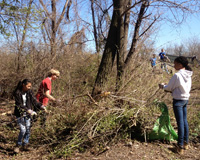What is an Invasive Plant?
Invasive plants are usually nonnative species that have been introduced intentionally or by accident and spread from human settings into natural areas with negative effects to our economy, environment or health. Other characteristics of invasives include:
- Free from the plant-eaters and parasites that keep them in check in their native ranges
- Reproduce rapidly and spread aggressively by (a) producing a large number of seeds and (b) sometimes reproducing by sprouting from their roots and stems
- Take over natural areas and altering biological communities.
Mid-Atlantic Invasive Plants. - Over 280 species of invasive plants have been reported to be impacting natural areas in the six mid-Atlantic states (Delaware, Maryland, New Jersey, Pennsylvania, Virginia, and West Virginia). These impacts include displacing native plants and animals, reducing native species biodiversity, altering soil properties, water and light regimes, and destroying wildlife habitat.
Invasives in DC & Mid-Atlantic
In the last several centuries many non-native plant species have been introduced to the District of Columbia (DC) metropolitan area, a city with large forested parks…….read more.
 Integrated Pest Management / IPM
Integrated Pest Management / IPM
Chemical herbicides used to be seen as the best way to control invasive plants, but the effects these chemicals had on the environment led to the creation of Integrated Pest Management, or IPM. ….read more.
 Weed Warriors
Weed Warriors
The Weed Warrior program works with communities to reduce the negative impact of invasive plants in places, such as parks, trails, and open spaces. The program offers education about invasive weeds and methods for control or eradication.….read more.
Educational Resources
-
PLANT INVADERS OF MID-ATLANTIC NATURAL AREAS
The newly revised and updated edition is now available for viewing online.
The new edition covers 80 species and is also available for download. -
Invasive Plant Tutorial. - The Invasive Exotic Plant (IEP) Management Tutorial for Natural Lands Managers provides a "one-stop-shop" for natural resource managers who are interested in organizing on-the-ground efforts to prevent, manage and control invasive plants.
State/Regional Invasive Plant Networks
- Mid-Atlantic Exotic Pest Plant Council http://www.maipc.org/
Regional and National Online Invasive Plant Databases

